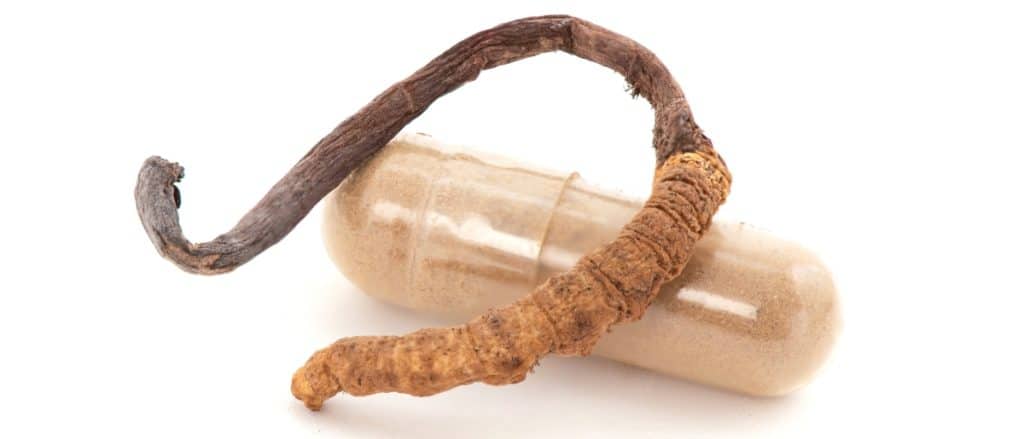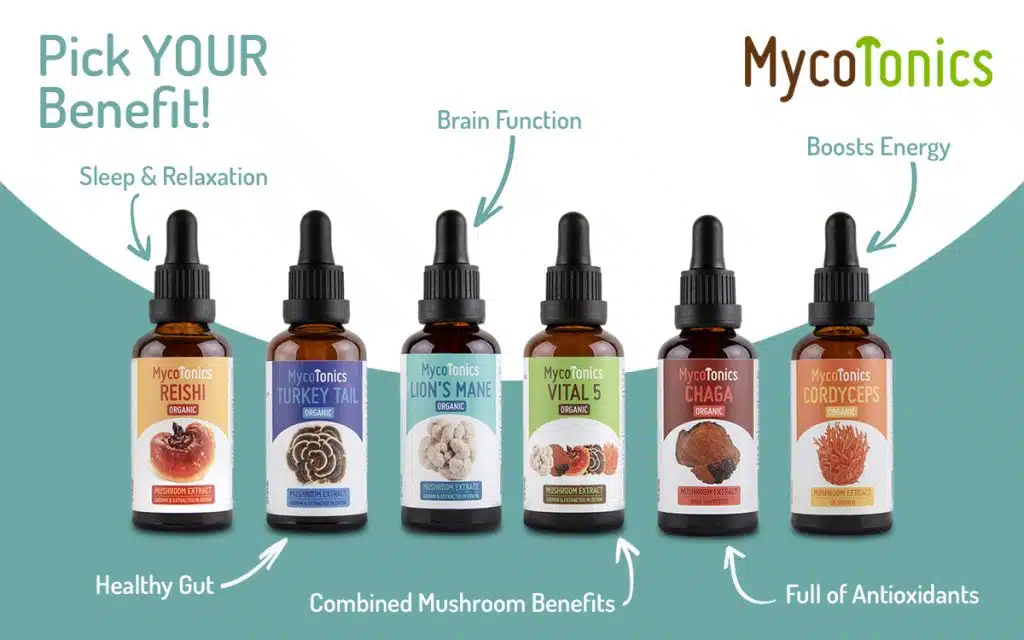Cordyceps are rather unusual fungi that grow as parasites on insects, resulting in the death of the host insect.
For centuries, traditional Chinese healers have dried and powdered the remains of the insects, as these contain cordyceps mycelium, and the fruiting body that sprouts from the insect’s head.
They used the resulting powder to treat kidney disease, fatigue and low sex drive. It was also used as a tonic after severe illnesses to help improve energy, appetite and sleep patterns.
However, modern-day research suggests the potent bioactive compounds in cordyceps have the potential to provide many more health benefits.
They may improve athletic performance and brain function, promote heart, liver and kidney health, help fight cancer and reduce the effects of aging.
Read on to learn more about cordyceps mushroom health benefits, the different types of cordyceps in mushroom supplements and the potential side effects of consuming cordyceps.
If you’re in the UK and want to try them as a food supplement please check out our range of extracts called MycoTonics.
What Are the Benefits of Taking Cordyceps?
Mycologists have discovered more than 400 species of cordyceps, but two in particular, cordyceps sinensis and cordyceps militari, have caught the attention of medical communities.
These two have become the focus of numerous scientific studies investigating the health claims made by traditional healers.
And the resulting data confirms cordyceps potential to provide several health benefits, including:
1. Reducing Fatigue
Researchers have conducted many studies exploring cordyceps’ potential to reduce physical fatigue with promising results.
In a 2004 study using 37 healthy older adults, researchers found that VO2 max (maximal oxygen uptake) in participants taking 3 grams of cordyceps Cs-4 daily increased by 7%.
VO2 max records the maximum amount of oxygen a person’s body can absorb and use during exercise, and researchers use it to measure an individual’s aerobic capacity or fitness level.
Participants in the study who were taking placebo pills showed no change in VO2 max, suggesting cordyceps may improve aerobic capacity and reduce fatigue.
Another study, using mice this time, explored the effects of the polysaccharides from cordyceps militaris on physical fatigue induced by forced swimming.
The mice given cordyceps for 28 days before swimming had prolonged swimming times, decreased lactic acid in their blood, and increased liver and muscle glycogen content compared to the mice who did not receive cordyceps.
The data recorded during this study also suggests that cordyceps militaris may have antifatigue effects.

2. Improving Athletic Performance
This benefit is probably the most well-known of all the cordyceps benefits. Many athletes looking for a boost turn to cordyceps to help improve their physical performance and endurance.
Researchers believe cordyceps may benefit athletic performance by functioning as an antioxidant, reducing inflammation, improving blood flow and increasing oxygen utilization.
But, studies into cordyceps mushrooms’ ability to improve athletic performance have produced mixed results.
The results of a study conducted in 2010, using 20 healthy adults between the ages of 50 and 75, suggest that supplementation with cordyceps Cs-4 improves exercise performance in older people.
Participants in this study took either Cs-4 or placebo capsules for 12 weeks.
At the end of the study, participants taking cordyceps showed a significant improvement in metabolic and ventilatory threshold, while the placebo group showed no notable changes.
Neither group showed an increase in VO2 max, which differs from the results of a study on younger adults who, after taking cordyceps for three weeks, showed a significant increase in VO2 max.
But even though results vary, athletes seem to feel the benefits and two women who broke world records for the 1500, 3000 and 10000 meter runs in 1993 in Beijing attributed their record-breaking wins to cordyceps.
3. Promoting Brain Health
Numerous studies exploring the potential cognitive benefits of cordyceps suggest they may contribute to brain health in several ways, including:
Improving Focus and Mental Clarity
Cordyceps’ ability to boost energy and reduce fatigue provides more than physical benefits. It may also contribute to sharper focus and enhanced mental clarity.
Cordyceps promote a steady release of energy and increased oxygen uptake. They also increase the blood flow to brain cells, fighting mental fatigue and promoting alertness and better concentration.
Protecting Brain Cells
A 2008 study found that the antioxidants in cordyceps may protect brain cells by reducing damage from oxidative stress, potentially slowing down age-related cognitive decline.
Another 2019 study exploring the neuroprotective effects of Cordyceps militaris suggests they have the potential to protect the hippocampus and help people recover from vascular dementia and neuroinflammatory disorders.
And a recent 2021 study found that cordyceps may help people recover from traumatic brain injuries by decreasing inflammation and increasing blood flow to damaged brain cells.
Enhancing Memory and Learning
If you’re looking to boost your memory and learning abilities, cordyceps mushrooms may be able to help you.
Studies suggest that cordyceps extracts may positively effect memory retention and the ability to acquire new information.
In a 2018 study using mice, findings indicated that cordyceps may improve learning and memory by scavenging free radicals, preventing oxidative damage, and protecting the nervous system.

4. Helping to Prevent and Fight Cancer
Although we need more human studies, current test-tube studies suggest cordyceps may help slow the growth and spread of cancer cells.
In 2022, scientists reviewed past studies attempting to understand the anti-tumor effects of cordyceps and how the compounds in cordyceps cause these effects.
Their analysis suggests cordyceps may act directly on tumor cells, preventing them from growing and spreading. It achieves this by regulating the immune system and increasing immune cells’ anti-tumor functions.
Scientists have explored cordyceps’ anti-tumor effects on several types of human cancer cells, including colon, lung, skin and liver cancer cells.
And in all these studies, cordyceps demonstrated the potential to slow the growth and spread of the cancer cells.
5. Helping Manage Diabetes
Diabetes is a health condition caused by too much sugar in the blood, and is one of the leading causes of death in many countries.
Usually, the body produces the hormone insulin to transport sugar from the blood into the body’s cells to provide energy.
But when the body does not produce or respond to insulin correctly, excess sugar stays in the blood, elevating blood sugar levels and causing severe health problems.
Cordyceps may be able to help manage diabetes and several studies, in vitro and using animals, indicate they have the potential to lower blood sugar levels.
According to these studies, cordyceps militaris extract may help lower blood sugar levels and help with type 2 diabetes by improving insulin sensitivity and regulating the bacteria in the gut.
6. Promoting Heart Health
Cordyceps may contribute to heart health by reducing cholesterol, treating arrhythmia and preventing heart injuries.
Several animal studies suggest that cordycepin, one of the important bioactive compounds in cordyceps, may help to reduce LDL cholesterol and triglyceride levels.
This helps to keep the heart healthy as high levels of LDL cholesterol and triglycerides increase the chances of cholesterol build-up in arteries and heart disease.
Another way that cordyceps is said to assist with heart health is by stabilizing heart rates, and scientists have conducted numerous human trials exploring these claims.
An arrhythmia, or irregular heartbeat, is a treatable condition, but if left untreated, it can cause a stroke or heart failure, damaging the brain, heart or other organs.
A 2022 review of nineteen studies on 1,805 patients with arrhythmia found that cordyceps may effectively stabilize the heart rates of patients with arrhythmia.
Research also suggests that the adenosine in cordyceps may have heart-protective effects.
In a study on rats with chronic kidney disease, cordyceps significantly reduced kidney disease-induced heart injuries that could increase the chances of heart failure.

7. Reducing inflammation
While some inflammation is good and helps the body heal, long-term inflammation can cause chronic health conditions.
Studies indicate that cordyceps may help reduce chronic inflammation by inhibiting the production of pro-inflammatory cytokines and regulating the body’s inflammatory system.
As a result, researchers believe cordyceps may be beneficial as an anti-inflammatory dietary supplement or drug.
8. Providing Anti-Aging Benefits
Oxidative stress, which occurs when there are too many free radicals and too few antioxidants in the body, is one of the main drivers of aging and age-related diseases.
Cordyceps contain several potent antioxidant compounds, including polysaccharides and cordycepin, that neutralize free radicals, protecting the body from oxidative stress and increasing longevity.
Several studies in aging mice found that cordyceps increased antioxidant activity, improving brain and sexual function and extending their lifespan.
And mice are not the only test subjects. In another study, cordyceps extended the lives of fruit flies.
These findings suggest cordyceps may increase human longevity, but we need more human studies to confirm their anti-aging effects.
9. Supporting Liver and Kidney Health
Cordyceps benefits the liver and kidneys by helping these vital organs function more efficiently.
Animal studies show it has the potential to normalize liver enzymes, improve liver function and slow the development of cirrhosis.
And a human study using 25 patients with chronic hepatitis B suggests cordyceps may be an effective treatment for hepatic fibrosis, the excessive scarring caused by chronic, repeated liver cell injury.
Scientists have also experimented with growing cordyceps militaris culture using deep ocean water, and the results suggest that this improves the protective effects it has on the liver.
And it’s not only the liver that benefits, research suggests that supplementation with cordyceps may also improve kidney function.
In a study on 51 patients suffering from chronic renal failure, 3 to 5g of Cordyceps sinensis daily improved the kidney and immune functions of the patients.
However, a review of 22 studies involving 1746 participants to explore the potential of cordyceps sinensis for treating chronic kidney disease found too little high-quality evidence to make definitive conclusions.
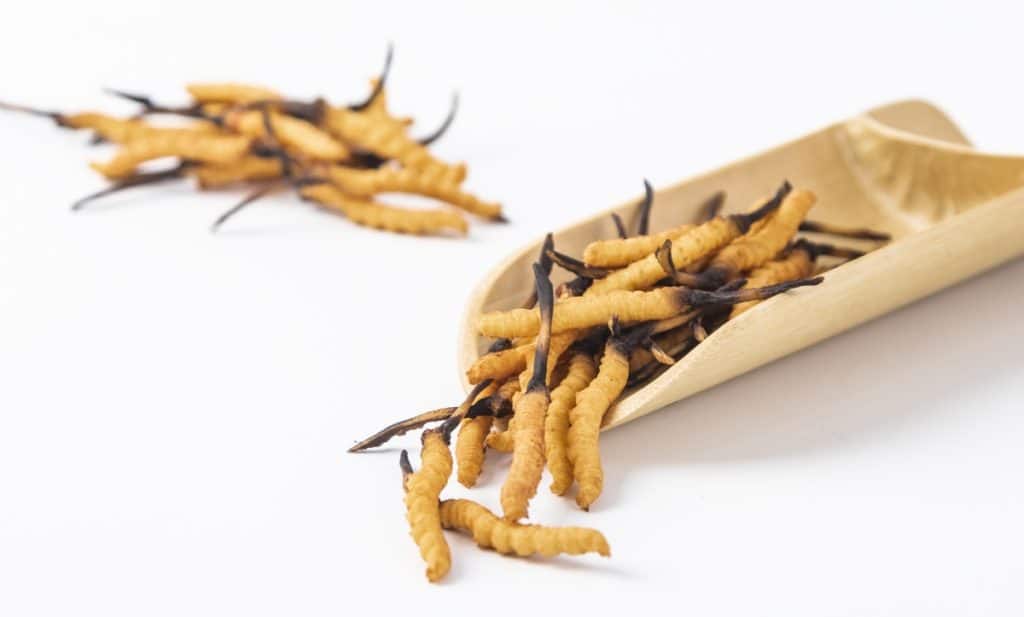
Cordyceps Mushroom Supplements
Cordyceps is not the kind of mushroom you can enjoy as part of a meal. Historically, most people consumed them in the form of a mushroom powder or in tea.
Nowadays, cordyceps mushroom supplements usually come as liquid extracts, powders or capsules.
Because wild cordyceps sinensis is difficult to find and pricey, most supplements contain other forms of cordyceps.
The 3 types of cordyceps most commonly found in supplements are cordyceps CS-4,cordyceps myceliated grain and cordyceps militaris.
Here’s some more information on the different types of cordyceps mushroom supplements to help you choose the one that suits your needs:
Wild Cordyceps Sinensis
Cordyceps sinensis (now officially called Ophiocordyceps sinensis) is known for its use in traditional Chinese medicine and is commonly called Yartsa Gunbu or the caterpillar fungus.
It’s a parasitic fungus that infects the larvae of the ghost moth, then kills its host and produces a mushroom that grows out of the caterpillar’s head.
Usually found at high elevations on the Tibetan plateau and parts of China, it sometimes also grows in the Himalayan regions of India, Nepal and Bhutan.
In the past, cordyceps sinensis was rarely used in cordyceps supplements as it was challenging to find and in high demand, making it the most expensive mushroom in the world.
But Chinese scientists, after much research, have finally found a way to cultivate cordyceps sinensis on a large scale, which should impact its price and availability.
Cordyceps sinensis is full of antioxidants and is the most sought-after type of cordyceps because of its reputation and long history of use in traditional medicine.
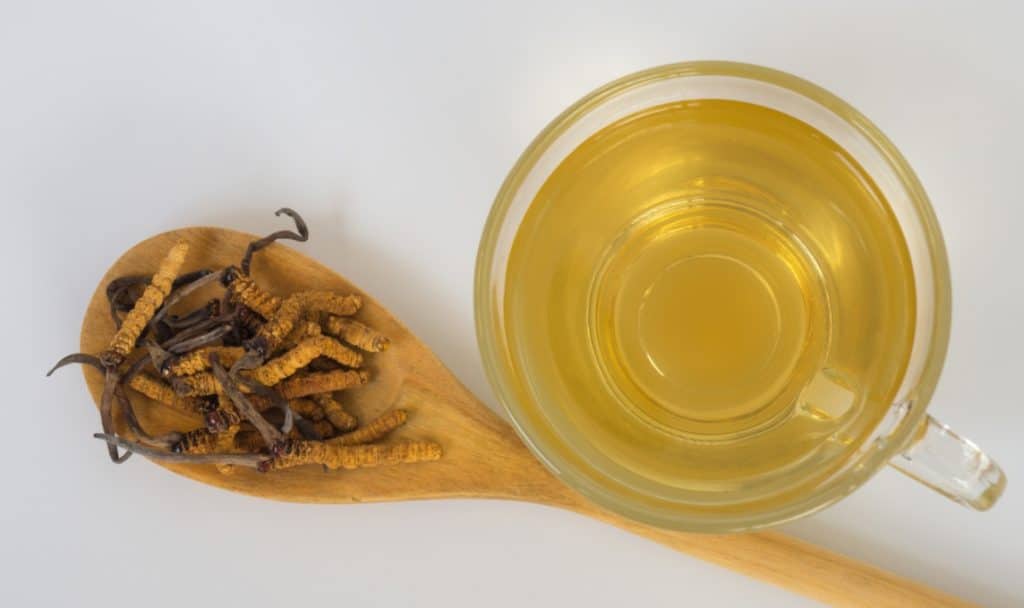
Cordyceps Militaris
Cordyceps militaris, also known as the scarlet club fungus, can grow on various insects and is usually found at high elevations throughout North America and Asia.
For years, cordyceps militaris was the only species scientists could cultivate on a large scale to make cordyceps more accessible and inexpensive.
Grown in controlled environments using rice as a substrate, cordyceps militaris fruiting bodies offer a consistent and reliable source of beta-glucans and cordycepin that provide many health benefits.
Producers often use the fruiting bodies of cordyceps militaris to make cordyceps mushroom extracts. They sell these extracts in liquid form as tinctures or dry the extract to make cordyceps extract powders and capsules.
Extracts made using cordyceps fruiting bodies generally contain more beta-glucans than supplements made with cordyceps mycelium.
Although not as popular as cordyceps sinensis, cordyceps militaris has similar properties and produces more cordycepin.
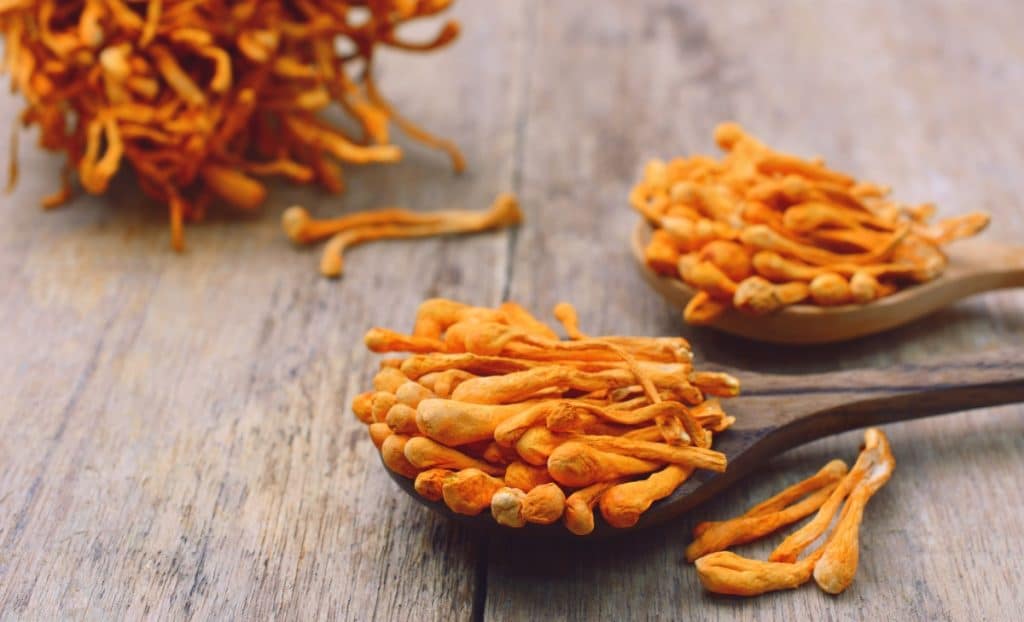
Cordyceps CS-4
Cordyceps CS-4 is a synthetic strain of cordyceps that mirrors the beneficial properties of natural cordyceps.
For many years, scientists tried to cultivate cordyceps sinensis without success. However, they did manage to grow cordyceps mycelium cultures. But these did not produce mushrooms.
They grew the cordyceps mushroom mycelium in nutrient-rich solutions that they could remove, leaving the scientists with pure mycelium.
With further studies and experimentation, the scientists produced a pure mycelium form of cordyceps called Cordyceps CS-4 that had similar properties to wild cordyceps sinensis.
Most supplements claiming to contain cordyceps sinensis actually contain Cordyceps CS-4.
Cordyceps Myceliated Grain
Many of the supplements produced in North America contain cordyceps myceliated grain, also sometimes called mycelium on grain (MOG) or mycelium biomass.
This method of producing cordyceps mycelium uses bags of sterilized grain as a growing medium instead of nutrient-rich solutions.
The difference between this mycelium and cordyceps CS-4 is that growers cannot separate the mycelium and the grain, meaning you get a mixture of mycelium and grain in the supplement.
As a result, supplements made with myceliated grain often contain less mycelium and lower levels of beneficial compounds.
It’s always important to read the labels of any supplements you plan on buying and check to see what type of cordyceps it contains.
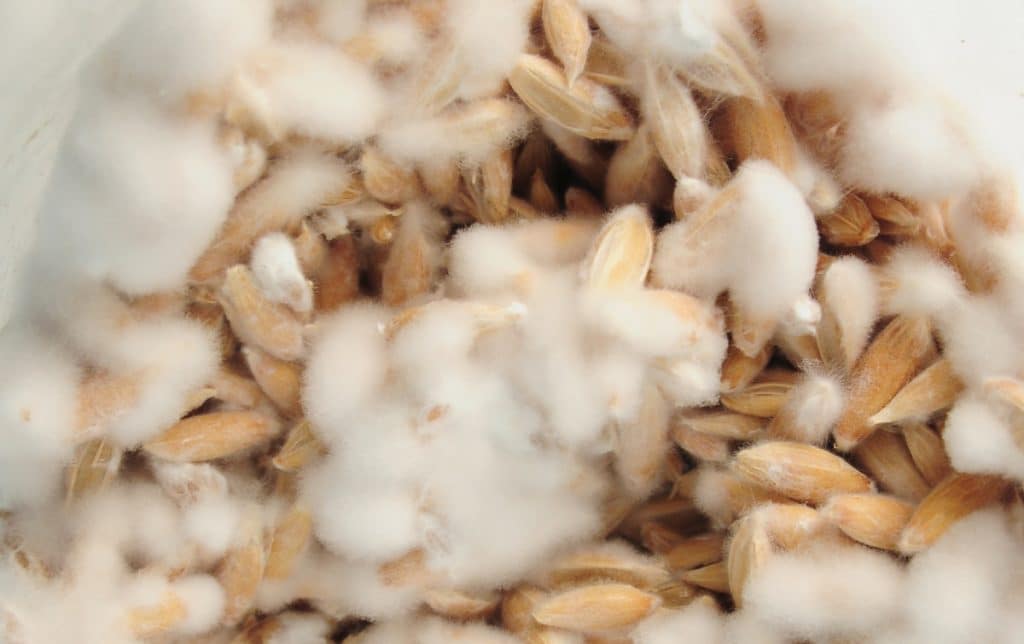
Cordyceps Dosage
Scientists commonly use 1 to 3g of cordyceps daily in human research studies, but there’s no official recommended dosage for cordyceps.
This dosage range is generally enough to provide health benefits without side effects, but results may vary depending on the type of cordyceps supplement and its strength.
When trying a cordyceps supplement for the first time, it’s best to follow the dosage recommendations on the product label.
Should I take Cordyceps daily?
Yes, we recommend taking cordyceps daily as the health benefits compound over time, and a daily dose provides the best results.
Studies confirm they provide enhanced benefits after regular use for several weeks. But there’s no research on the safety of continuously taking cordyceps for a year or more.
Best Time to Take Cordyceps
Everyone is different, and the best time to take cordyceps will vary depending on your daily routine.
However, as cordyceps supplements have the potential to provide an energy boost, many people like to take them in the morning to increase overall performance and vitality throughout the day.
Others take cordyceps before workouts or other strenuous tasks to maximize their performance and endurance.

Risks and Side Effects of Consuming Cordyceps Mushrooms
Cordyceps mushrooms are becoming more and more popular, and their long history of use in traditional medicine suggests they’re non-toxic and safe to consume.
But, although generally considered safe for most people, individual responses vary, and it’s wise to be aware of potential risks and side effects.
1. Allergic Reactions
Although Cordyceps are not typically allergens, some people have reported mild reactions to cordyceps, so it’s best to start with a small amount if you’re trying them for the first time.
2. Digestive Discomfort
While cordyceps are generally safe when consumed in moderate amounts, excessive doses may lead to digestive discomfort, including bloating, nausea and diarrhea.
Stick to recommended dosages, and if unsure, consult a healthcare professional.
3. Interactions with Medications
If you’re on medications or have underlying health conditions, consult your healthcare provider before adding cordyceps to your routine.
Their effects may interact with certain medications, including immunosuppressants, anti-coagulants, hormone replacement, and prednisolone medications.
4. Potential Blood-Thinning Effects
Cordyceps may have mild blood-thinning properties. If you’re on blood-thinning medications, it’s crucial to discuss the potential effects with your doctor to avoid complications.
5. Unknown Safety During Pregnancy
The safety of cordyceps during pregnancy and breastfeeding is unknown, and health practitioners generally recommend avoiding cordyceps if you’re pregnant or breastfeeding to protect the developing baby.
Final Thoughts
Cordyceps are unusual parasitic fungi that grow on insects, killing the host and using the nutrients in the remains to produce a mushroom that grows out of the insect’s head.
The most well-known species is cordyceps sinensis, that’s played a role in traditional Chinese medicine for centuries.
As wild cordyceps sinensis can be tricky to find and challenging to cultivate, it’s one of the most expensive mushrooms in the world. Fortunately, other cordyceps species are easier to cultivate, making cordyceps supplements more affordable.
Cordyceps are not the only mushrooms that offer remarkable health benefits. Most mushrooms are nutrient-dense and full of antioxidants, essential minerals and vitamins.
To learn more about other medicinal and gourmet mushrooms and their health benefits, visit our Mushroom Education Hub.
